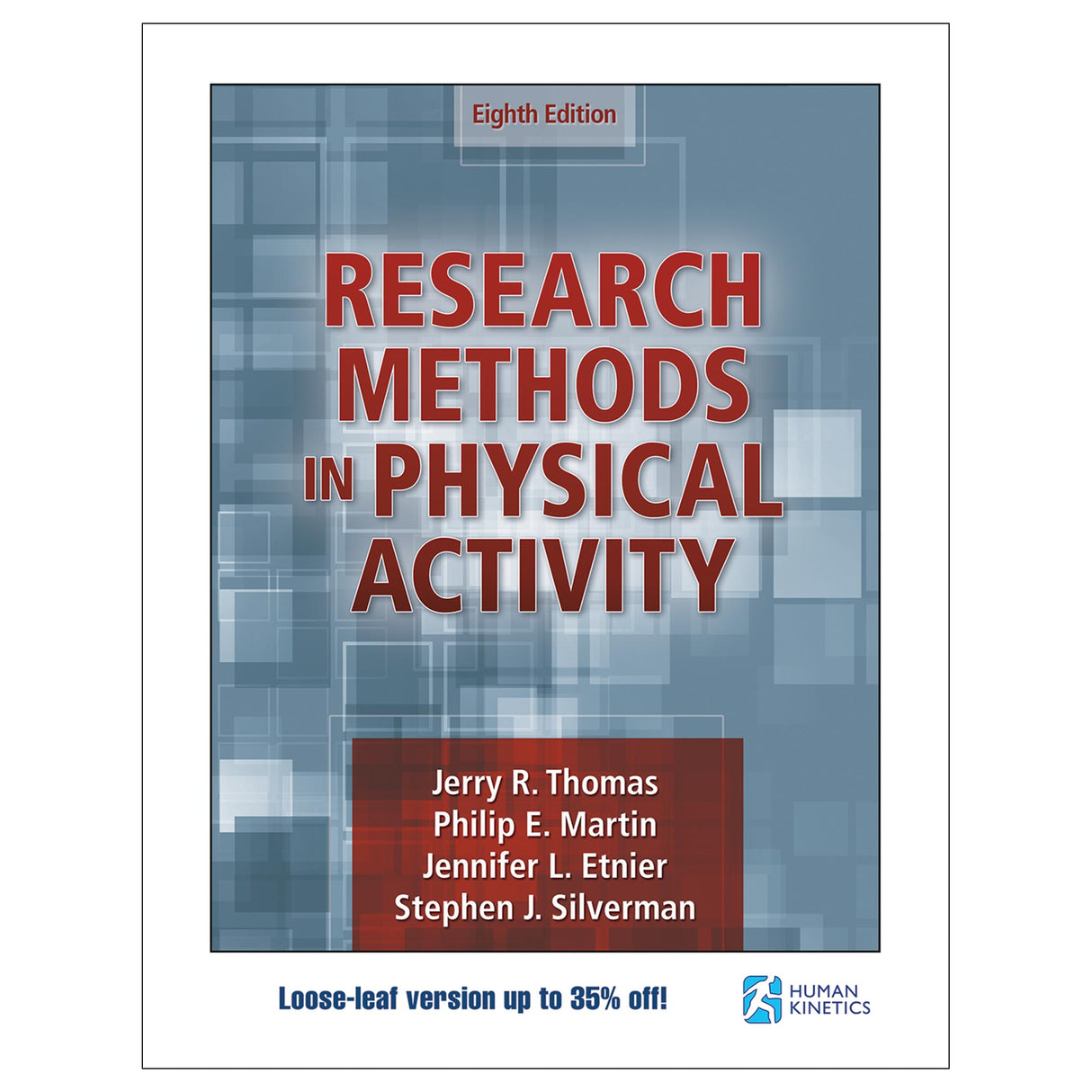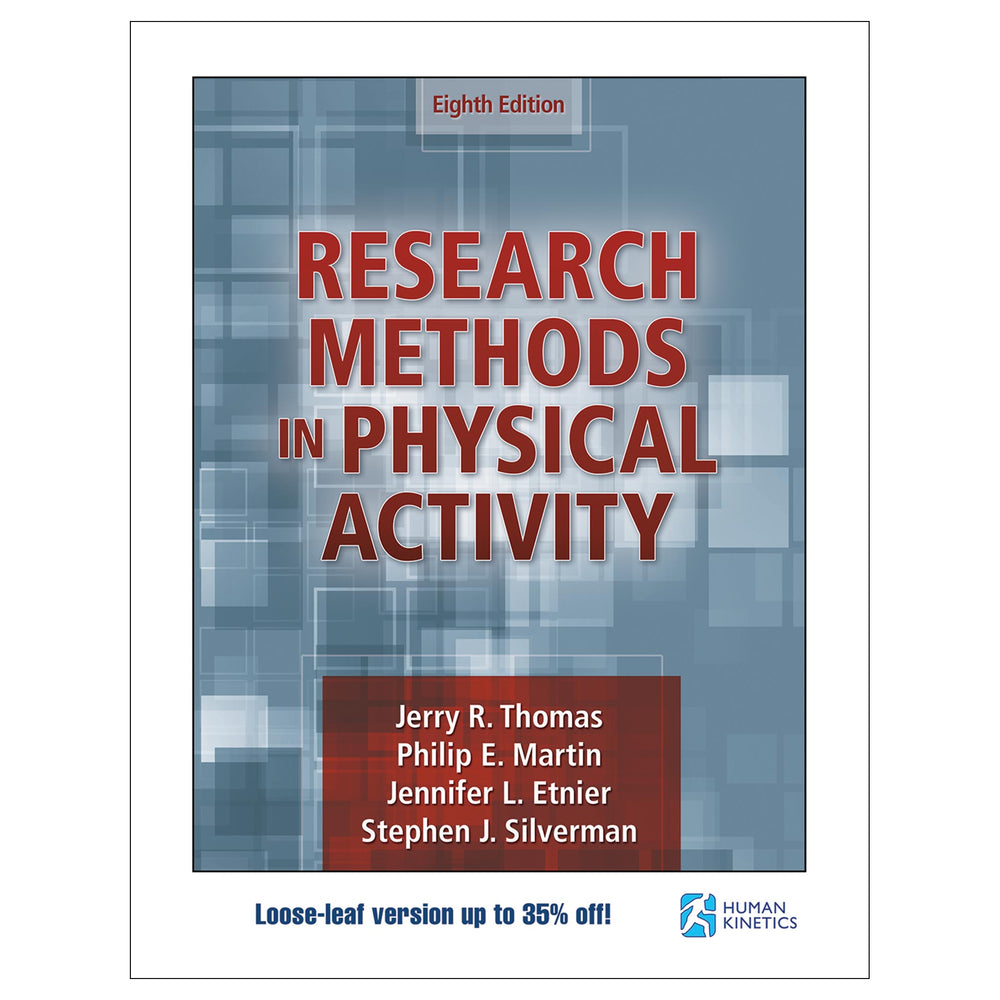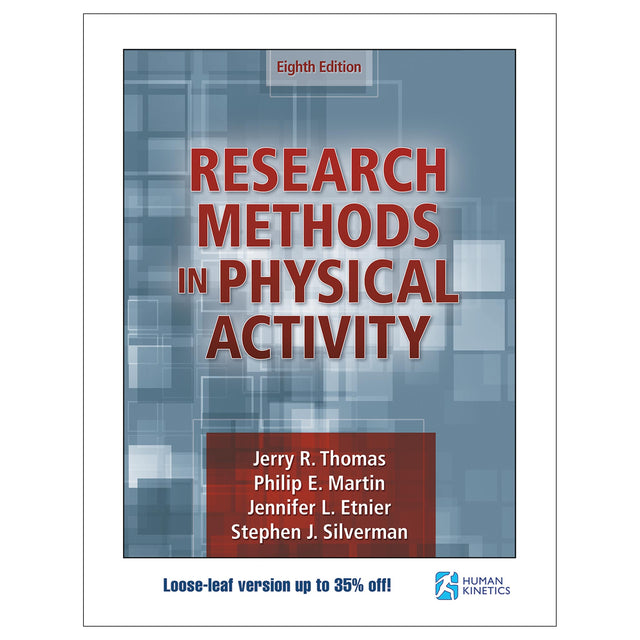Research Methods in Physical Activity 8th Edition-Loose-Leaf Edition
$99.00 CAD
Research Methods in Physical Activity, Eighth Edition, systematically guides students through the research process, introducing research methods, tools, and analysis techniques specifically for kinesiology and exercise science disciplines, including the subdisciplines of physical therapy, rehabilitation, and occupational therapy. The eighth edition continues its legacy with the authors’ trademark humor and is now enhanced with a new full-color layout.
This reputable text provides step-by-step information for every aspect of the research process. Part I presents an overview of the research process, from preparing the research plan to understanding ethical issues in research and writing. Part II introduces statistical and measurement issues in research. Part III presents various approaches to research and methodology—including qualitative, quantitative, and mixed methods—while scholarly contributors offer advice for addressing sociohistorical, experimental, epidemiological, and philosophical research questions. Part IV details how to develop and organize research papers and presentations, and it includes guidance for describing results for publication in a scientific journal. Statistical tables and guides are available in the appendix.
Joining longtime authors Jerry Thomas, EdD, and Stephen Silverman, EdD, are Philip Martin, PhD, and Jennifer Etnier, PhD, who bring fresh perspectives from the subdisciplines of biomechanics and sport and exercise psychology. Other enhancements to the eighth edition include the following:
- References have been updated throughout the text to present current research.
- Part II has undergone a major revision that makes statistical techniques more accessible.
- A new section on the Physical Activity Guidelines for Americans and other public health initiatives demonstrates epidemiology research in action.
- The chapter on philosophical research contains new issues from our increasingly diverse world, challenging students to think deeply.
- The full-color layout fosters an engaging learning experience and offers an enhanced data presentation.
Research Methods in Physical Activity, Eighth Edition, instills in students the confidence to devise, collect, analyze, and present their research in a competent manner. It is an essential text for all emerging researchers in physical activity.
Audience
Text for upper-undergraduate or graduate students in physical activity, exercise science, fitness, physical therapy, rehabilitation, and occupational therapy programs; also a reference for professionals in those areas.Chapter 1. Introduction to Research in Physical Activity
The Nature of Research
Unscientific Versus Scientific Methods of Problem-Solving
Alternative Models of Research
Types of Research
Overview of the Research Process
Parts of a Thesis: A Reflection on the Steps in the Research Process
Summary
Chapter 2. Developing the Problem and Using the Literature
Identifying the Research Problem
Purpose of the Literature Review
Basic Literature Search Strategies
Steps in the Literature Search
Summary
Chapter 3. Presenting the Problem
Choosing the Title
Developing the Introduction: Background and Justification
Stating the Research Purpose
Presenting the Research Hypothesis
Operationally Defining Terms
Basic Assumptions, Delimitations, and Limitations
Justifying the Significance of the Study
Differences Between the Thesis and the Research Article
Summary
Chapter 4. Formulating the Method
How to Present Methodological Details
Why Planning the Methods Is Important
Two Principles for Planning Experiments
Describing Participants
Selecting and Describing Instruments
Describing Procedures
Describing Design and Analysis
Establishing Cause and Effect
Interaction of Participants, Measurements, and Treatments
Summary
Chapter 5. Ethical Issues in Research and Scholarship
Seven Areas of Research Misconduct
Ethical Issues Regarding Copyright
Model for Considering Scientific Misconduct
Working With Faculty
Protecting Human Participants
Protecting Animal Subjects
Summary
Part II. Statistical and Measurement Concepts in Research
Chapter 6. Becoming Acquainted With Statistical Concepts
Why We Need Statistics
Use of Computers in Statistical Analysis
Description and Inference Are Not Statistical Techniques
Ways to Select a Sample
Ways to Assign Participants to Groups
Post Hoc Justifications
Difficulty of Random Sampling and Assignment: How Good Must It Be?
Measures of Central Tendency and Variability
Basic Concepts of Statistical Techniques
Data for Use in the Remaining Statistical Chapters
Summary
Chapter 7. Statistical Issues in Research Planning and Evaluation
Probability
Hypothesis Testing
Meaningfulness (Effect Size)
Power
Using Information in the Context of the Study
Summary
Chapter 8. Relationships of Variables
What Correlational Research Investigates
Understanding the Nature of Correlation
What the Coefficient of Correlation Means
Using Correlation for Prediction
Partial Correlation
Semipartial Correlation
Procedures for Multiple Regression
Logistic Regression
Discriminant Function Analysis
Moderators and Mediators
Multivariate Forms of Correlation
Summary
Chapter 9. Differences Between Groups
How Statistics Test Differences
Types of t Tests
Interpreting t
Relationship of t and r
Analysis of Variance
Analysis of Covariance
Experiment-Wise Error Rate
Understanding Multivariate Techniques
Summary
Chapter 10. Nonparametric Techniques
Chi Square: Testing the Observed Versus the Expected
Procedures for Rank-Order Data
Correlation
Differences Between Groups
Summary
Chapter 11. Measuring Research Variables
Validity
Reliability
Methods of Establishing Reliability
Intertester Reliability (Objectivity)
Standard Error of Measurement
Using Standard Scores to Compare Performance
Measuring Movement
Measuring Written Responses
Measuring Affective Behavior
Scales for Measurement
Measuring Knowledge
Item Response Theory
Summary
Part III. Types of Research
Chapter 12. Sociohistorical Process in Sport Studies
Development of the Discipline
Theory and Sport History
Relationship Between Theory and Method
Research Sources
Research Topics
Research Design
Data Analysis and Interpretation
Research Findings
Exemplary Studies in Sport History
Summary
Chapter 13. Philosophical Research in Physical Activity
Identifying the Purposes of Philosophical Research
Philosophical Inquiry Continuum
Locating a Research Problem
Analyzing a Research Problem
Summary
Appendix
Chapter 14. Research Synthesis (Meta-Analysis and Systematic Reviews)
Purpose of Research Synthesis
Presenting Effect Size Data
Summary
Chapter 15. Surveys
Questionnaires
Additional Considerations for Online Surveys
Delphi Method
Personal Interviews
Normative Surveys
Summary
Chapter 16. Other Descriptive Research Methods
Developmental Research
Case Studies
Observational Research
Unobtrusive Research Techniques
Correlational Research
Summary
Chapter 17. Physical Activity Epidemiology Research
U.S. National Physical Activity Guidelines and Plan
Observational Versus Experimental Research
What Is Physical Activity Epidemiology?
Definitions of Physical Activity and Its Components
Assessment of Physical Activity
Epidemiological Study Designs
Reading and Interpreting a Physical Activity Epidemiological Study
Summary
Chapter 18. Experimental and Quasi-Experimental Research
Sources of Invalidity
Threats to Internal Validity
Threats to External Validity
Controlling Threats to Internal Validity
Controlling Threats to External Validity
Types of Designs
Summary
Chapter 19. Qualitative Research
Procedures in Qualitative Research
Data Analysis
Concluding Remarks
Summary
Chapter 20. Mixed-Methods Research
Combining Quantitative and Qualitative Methods
Designing Mixed-Methods Research
Issues in Mixed-Methods Research
Examples of Mixed-Methods Research
Summary
Part IV. Writing the Research Report
Chapter 21. Completing the Research Process
Research Proposal
Thesis and Dissertation Proposals
Advisor and Dissertation Committee
The Good Scholar Must Research and Write
Scientific Writing
First Things Are Sometimes Best Done Last
Developing a Good Introduction
Describing the Methods
The Proposal Process
Preparing and Presenting Qualitative Research Proposals
Writing Proposals for Granting Agencies
Submitting Internal Proposals
Completing Your Thesis or Dissertation
Results and Discussion
Handling Multiple Experiments in a Single Report
Using Tables and Figures
Summary
Chapter 22. Ways of Reporting Research
Basic Writing Guidelines
A Brief Word About Acknowledgments
Thesis and Dissertation Format: Traditional Versus Journal
Helpful Hints for Successful Journal Writing
Revising Research Papers
Writing Abstracts
Making Oral and Poster Presentations
Summary
Appendix. Statistical Tables
Repeated measures with multiple dependent variables
Seven areas of research misconduct
What is physical activity epidemiology?




All ancillaries are free to adopting instructors through HKPropel.
Instructor guide. Includes chapter overviews, a sample course syllabus, supplemental class activities, a supplemental data set, and student handouts.
Test package. Contains 660 questions in short-answer and multiple-choice formats. The files may be downloaded for integration with a learning management system or printed for use as paper-based tests.
Chapter quizzes. Contains ready-made quizzes (9 or 10 questions each), drawn from the test package, to assess student comprehension of the most important concepts in each chapter.
Presentation package. Features more than 300 PowerPoint slides of text, artwork, and tables from the book that can be used for class discussion and presentation. The slides in the presentation package can be used directly within PowerPoint or printed to make handouts for students. Instructors can easily add, modify, and rearrange the order of the slides.
Image bank. Includes most of the figures, content photos, and tables from the text, sorted by chapter. These can be used in developing a customized presentation based on specific course requirements.





